The recipe cost breakdowns are a big part of Budget Bytes. And while you’re not likely to have the exact same food costs as me (prices vary quite a bit from location to location, day to day, and even store to store), I think it’s helpful to see how each ingredient can impact the overall cost of a recipe. So now I’d like to dive a little deeper to show you how I make these calculations, and teach you how to calculate recipe costs yourself. Because even if you do it once, I promise you’ll learn a lot!
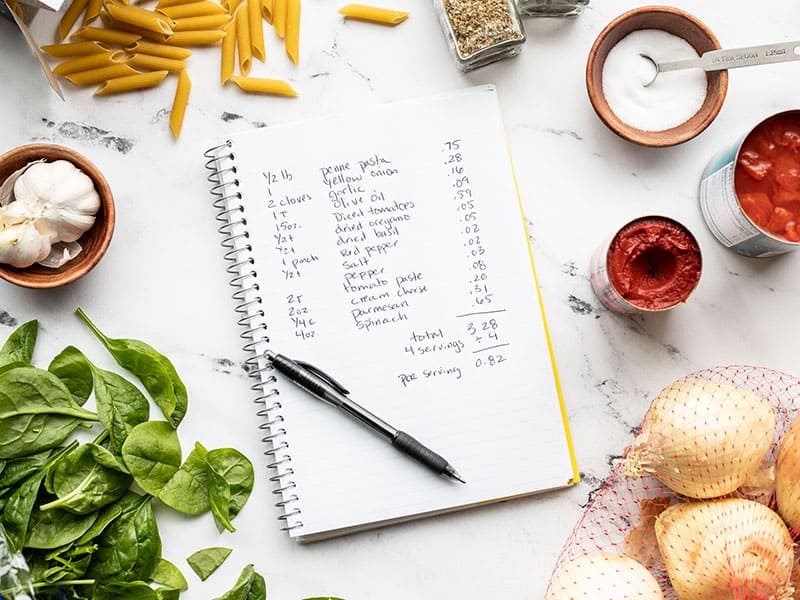
Why Calculate Recipe Costs?
My big “Ah-ha!” moment came when I calculated the cost of my first few recipes. I was always very mindful of the total amount I spent at the grocery store every week, but seeing the breakdown of each ingredient and the total recipe cost that truly revolutionized my way of cooking.
Seeing this breakdown helped me learn how to tweak recipes to make them more filling for less money, while maintaining maximum flavor. I learned that scaling back just a little on the most expensive ingredients (nuts, cheese, meat, etc.) dramatically reduced recipe costs, but didn’t have a huge impact on flavor. Likewise, I learned which inexpensive ingredients helped give my food a big flavor kick for pennies (green onions, cilantro, freshly cracked pepper, dried herbs, etc.), and which ingredients I could use to bulk up a recipe without greatly increasing the total cost (rice, pasta, beans, lentils, cabbage, carrots, potatoes, etc.).
What Method Do You Use?
Here on Budget Bytes I use the same method of calculating recipe costs used by commercial food service operations—adding the costs of each ingredient used, in the amount used, rather than adding the full price of items purchased. Some argue that you can’t just buy 2 Tbsp of olive oil, so the recipe actually costs more to make. The counter argument to that is that you don’t buy an entire bottle of olive oil every time you make a recipe, nor do I consider an ingredient “free” if I already have it in my kitchen and didn’t need to buy it for that recipe. Both methods have their caveats, but I find the method used here to be the most representative of the recipe’s true cost.
What Do I Need to Calculate the Cost of a Recipe?
The process is simple and doesn’t require a lot of time or “equipment.” It’s so simple, in fact, that I do this, by hand, for every single recipe on this website (well over 1000 recipe at this point). To calculate recipe costs you’ll need:
- Your receipts
- Original ingredient packages
- Pen and paper
- Calculator
- Grocery store website (as a backup for sourcing prices)
How To Calculate Recipe Costs – Step by Step Tutorial
Okay, so let’s walk through, step by step, what I do to calculate the cost of a recipe on Budget Bytes. For this tutorial, we’ll be using the Creamy Tomato and Spinach Pasta recipe as an example.
Step 1: Write down the recipe ingredients and quantities
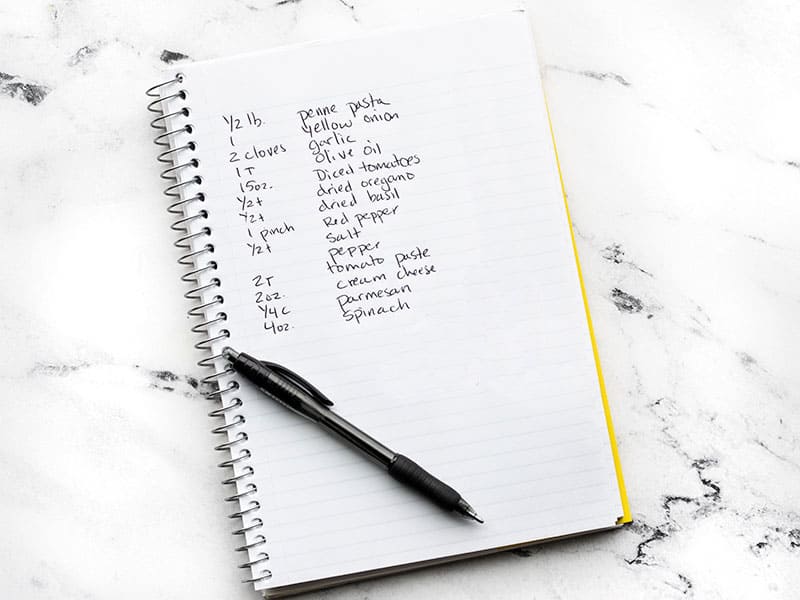
This post contains some affiliate links, which means that we make a small commission off items you purchase at no additional cost to you.
If you like to print your recipes, you can do the calculations right on the printed version of the recipe. I always do my calculations in my recipe development notebook. You’ll fill out the prices in the right hand column as you do the calculations.
Step 2: Fill in prices for ingredients that were used “whole”.
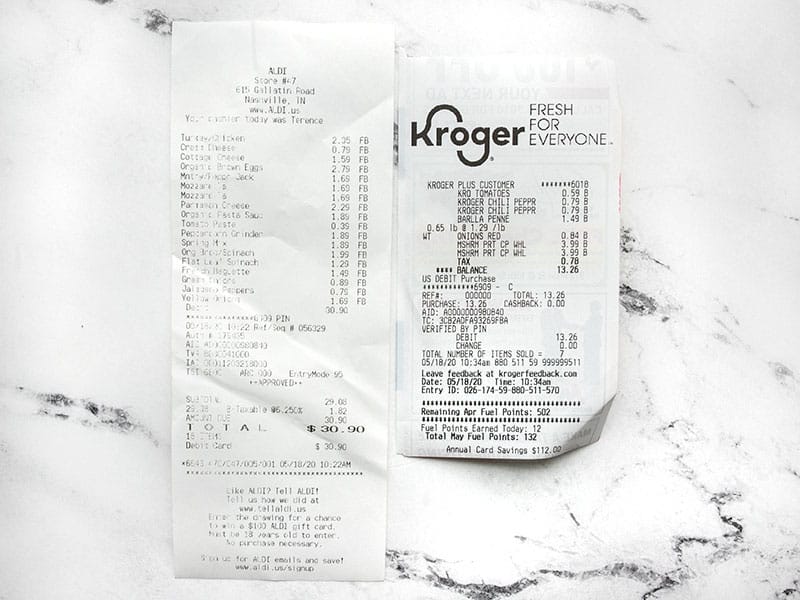
Gather your receipts and record the prices for any ingredient that you used in the “whole” form. This could be ingredients like a can of tomatoes, a cucumber, maybe a jar of pasta sauce, a single bell pepper, etc. In this Creamy Tomato and Spinach Pasta there was only one ingredient that I used in the full volume purchased—diced tomatoes. You can see this item listed as “kro tomatoes $0.59” on the Kroger receipt. Record the price next to this item on your recipe ingredient list.
Note: If you don’t have your receipts, check your grocery store’s website. Some larger stores, like Kroger, allow you to look up items online and the price will be displayed.
Step 3: Calculate Bulk Produce Items
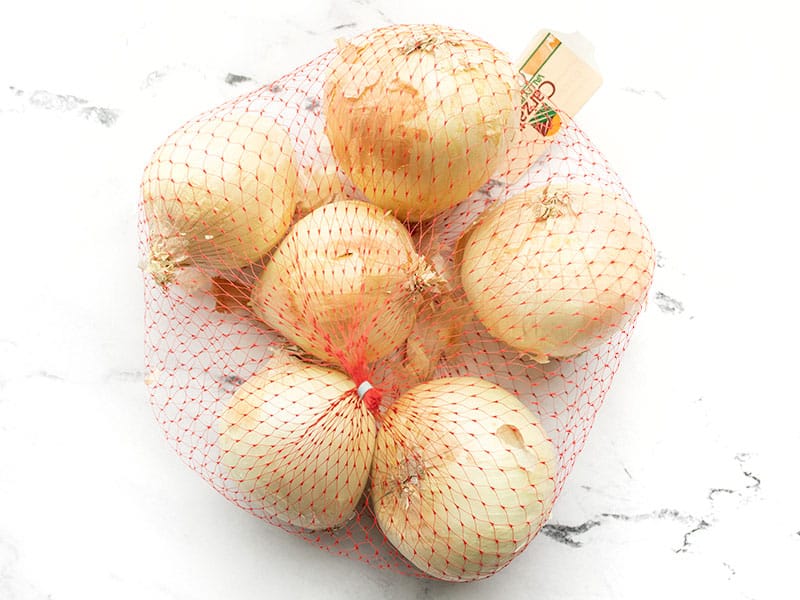
For bulk produce items, take the total price listed on the receipt and divide by the number of items purchase. The total price for this bag of yellow onions listed on the receipt was $1.69 and there are six onions in the bag, so each onion is approximately $0.28. Record this price on your recipe ingredient list.
This method works good for other bagged produce, like apples, carrots, oranges, lemons, potatoes, etc. and also things like packages of chicken thighs or breasts.
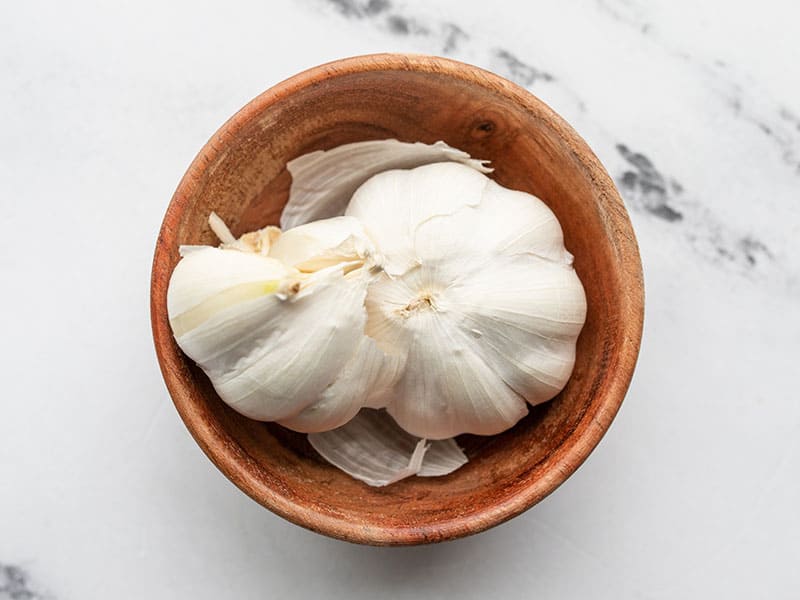
For garlic, each head is usually around $0.60-$0.65 and I get on average about 8 good sized cloves from each head, so I just estimate about $0.08 per clove.
Step 4: Use Package Labels to Calculate Partial Ingredient Costs
For most ingredients you’ll need to use the information listed on the ingredient packages to determine the cost of the amount used in the recipe. Here are some examples:
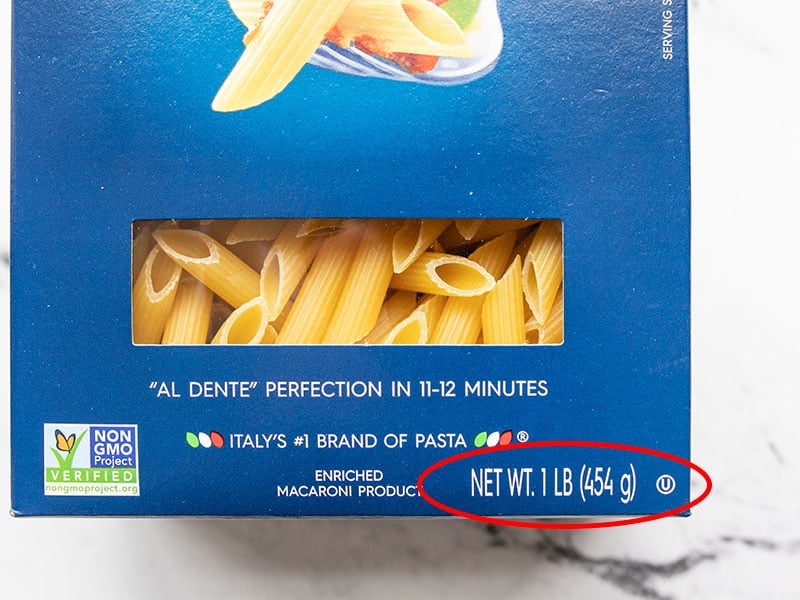
This recipe used 1/2 lb. of penne pasta. The whole box (1 lb.) cost $1.49. Since I used half the box, the cost of the amount used is $1.49 ÷ 2 = $0.75.
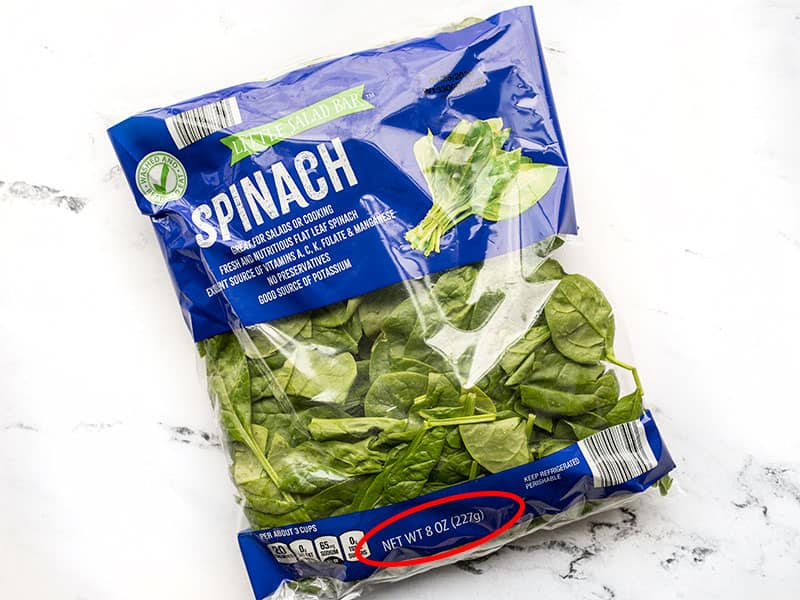
The same method was used for this bag of spinach. The full 8 oz. bag cost $1.29, so the cost of the 4 oz. used is $1.29 ÷ 2 = $0.65.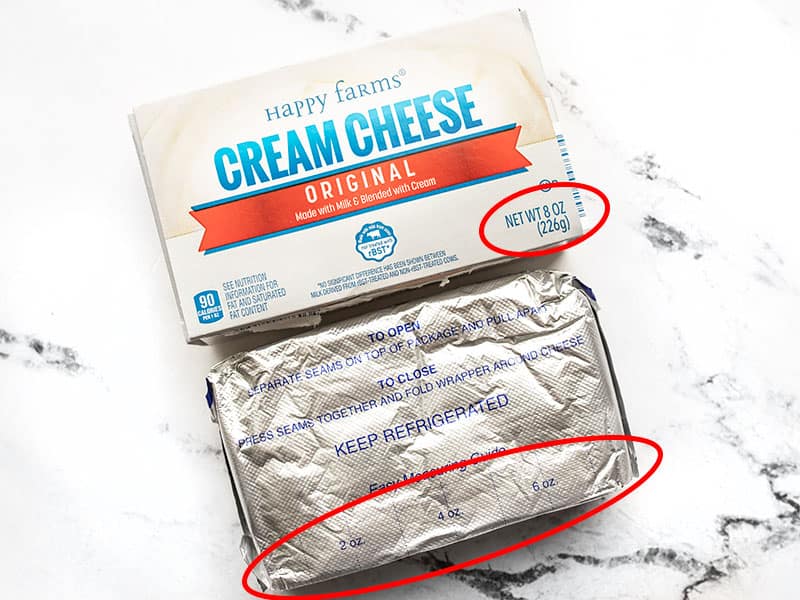
Sometimes the manufacturers are nice and provide helpful guides for measuring. This full 8 oz. package of cream cheese cost $0.79, so the cost of the 2 oz. used in the recipe is $0.79 ÷ 4 = $0.20.
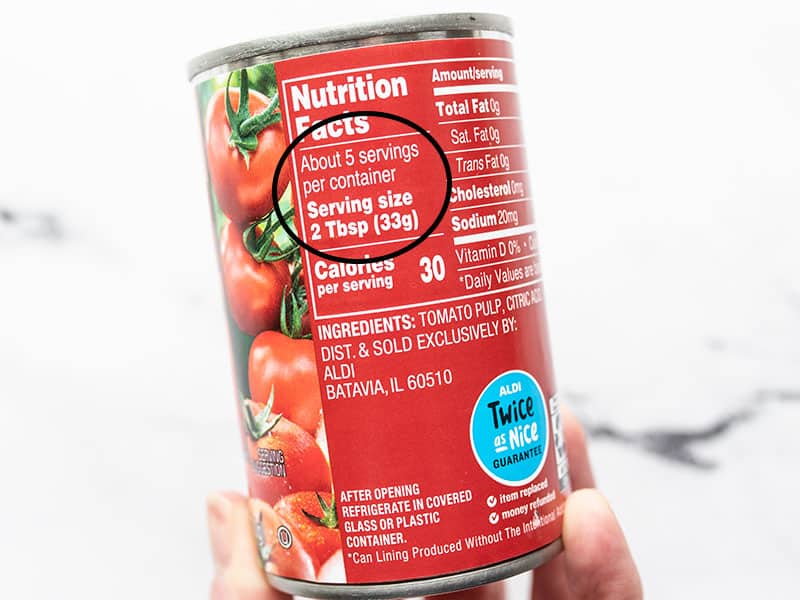
Sometimes the calculations can get a little more involved. The cost of this 6 oz. can of tomato paste was $0.39. We can see on the nutrition label that there are 5 servings of 2 Tbsp in the can, or a total of 10 Tbsp per can. We used 2 Tbsp for the recipe, so the cost of what we used is $0.39 ÷ 5 = $0.08.
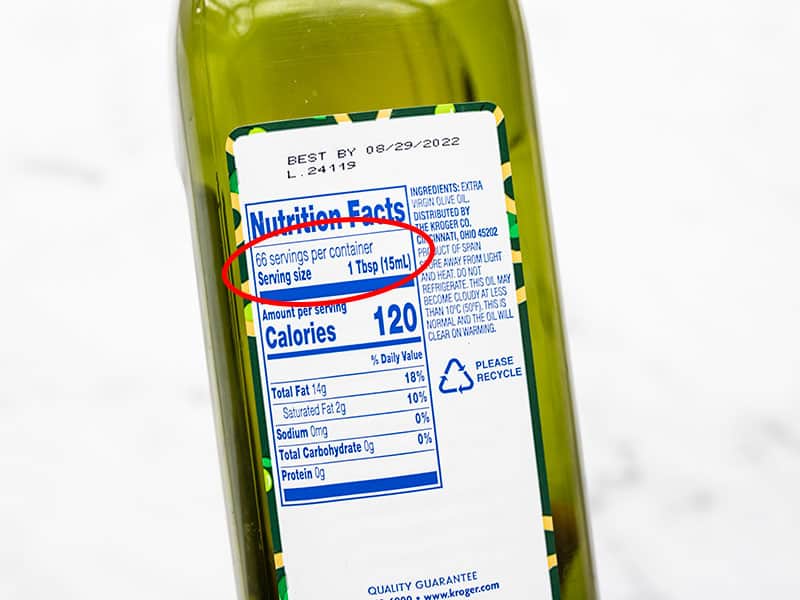
I bought this bottle of olive oil a while back, so I had to refer to Kroger.com to get the price. The total price for this bottle was $5.95. We can see on the nutrition label that there are 66 servings of 1 Tbsp in the whole bottle. We used 1 Tbsp for the recipe, so the cost of what we used is $5.95 ÷ 66 = $0.09.
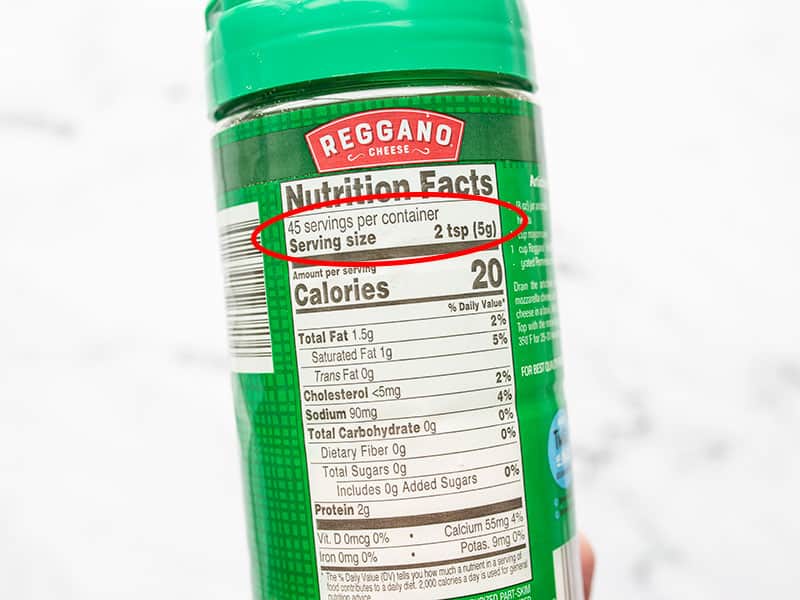
This Parmesan cheese is about as complicated as the calculations usually get because we’re converting between unit types. We see on the label that there are 45 servings of 2 tsp in the whole bottle. We used 1/4 cup in the recipe. So first I calculated the cost per tsp: $2.29 (total bottle price) ÷ 45 ÷ 2 = $0.025 per tsp. I know there are 3 tsp per tablespoon, and 4 tablespoons per 1/4 cup, so I calculated a little further: $0.025 x 3 x 4 = $0.31 per ¼ cup.
Step 5: Estimate Costs for Herbs and Spices
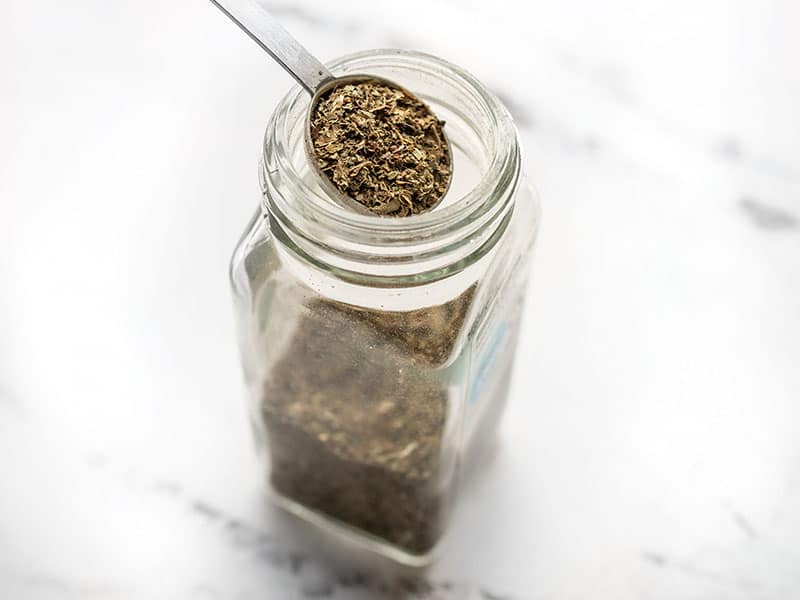
Herbs and spices don’t have nutrition labels with serving sizes to work with, and often the entire container only weighs less than 2 oz. Unfortunately I don’t have a kitchen scale that is sensitive enough to weigh something as light as a 1/2 tsp of a dry herb. So, for my purposes I use a generic (and generous) allotment of $0.10 per tsp for most dried herbs and spices. For salt and pepper I estimate a little less and for any rare herbs or spices I double the generic estimation. So, for this recipe: 1/2 tsp dried basil = $0.05, 1/2 tsp dried oregano = $0.05, 1 pinch crushed red pepper = $0.02, 1/2 tsp salt = $0.02, freshly cracked pepper = $0.03
Step 4: Add it all together!
So finally, we have all of the prices of the ingredients filled in on the recipe ingredient list. Now just simply add them all together and then divide by the number of servings and you’ve got the price per serving. So for this recipe, the total cost was $3.28 and with four servings that’s $3.28 ÷ 4 = $0.82 per serving.
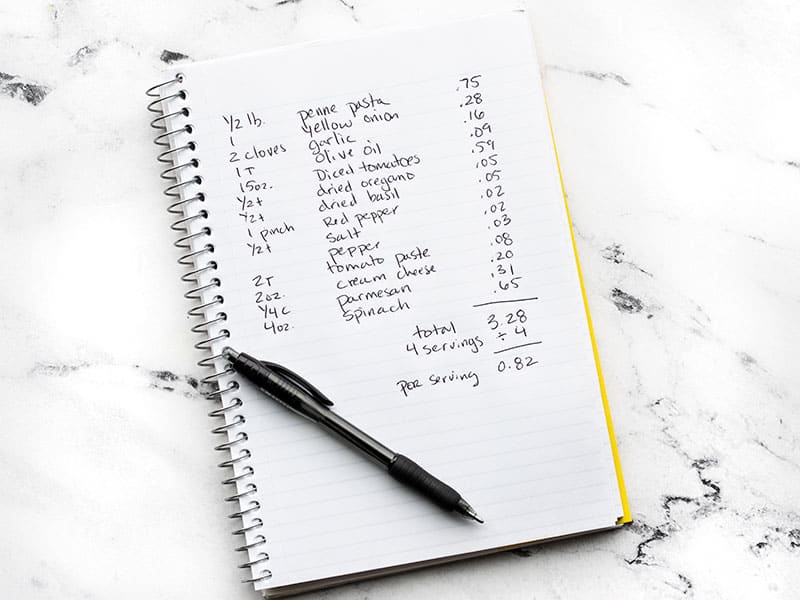
As you can see, it’s not an exact science, but it will definitely shed some light on where your money is really going. I hope you try it out at least once just to see how it goes. If you want to do it on a regular basis, you can start a spreadsheet with price per unit information for your pantry staples. This way you’ll have a record of the price for items that you may only buy a few times per year (and probably won’t have the receipt handy). Luckily, my blog acts as a “record” of these prices, so I can quickly refer back to my last purchase price.
What About Electricity, Gas, and Water?
Every now and then I get a question about how utilities add to my recipe costs. Unfortunately I don’t have a way to measure the amount and cost of the most of the utilities used in the recipes, but I’m confident that it would be a very small amount. For instance, in this recipe I used 1/2 cup water in the sauce. After checking my last water bill, I paid $0.003 per gallon of water. I round to the nearest cent for these calculations, so the cost of the 1/2 cup water in this recipe is negligible. Water is easy to measure, but I don’t think I could measure the amount of gas or electricity used to heat the oven.
Handy Conversions for Calculating:
- 3 tsp = 1 Tbsp
- 4 Tbsp = 1/4 cup
- 2 Tbsp = 1 fluid ounce
- 16 Tbsp = 1 cup
- 2 fluid ounces = 1/4 cup
- 8 fluid ounces = 1 cup
- 16 weight ounces = 1 pound
NOTE: “fluid ounces” are a volume unit, weight ounces are a measurement of mass. Solid ingredients are usually listed as weight ounces, liquid ingredients are usually listed in fluid ounces. 8 fluid ounces of one ingredient may not equal 8 weight ounces of that same ingredient. That will depend on the individual density of the ingredient. Cheese is a great example. 4 oz. (weight) of cheese is equal to about one cup (volume) of shredded cheese. One cup is 8 fluid ounces in volume, but only 4 weight ounces of shredded cheese.
Try It Yourself!
I hope I didn’t scare you off with all these calculations! It really is quite simple, especially after you do it a few times. If you’re interested in giving it a shot, start with a simple recipe that only has 3-5 ingredients and see how you do! Then, let me know how it worked out in the comments below. :)
P.S. Did you know you can browse our recipes by Cost per Recipe and Cost per Serving?


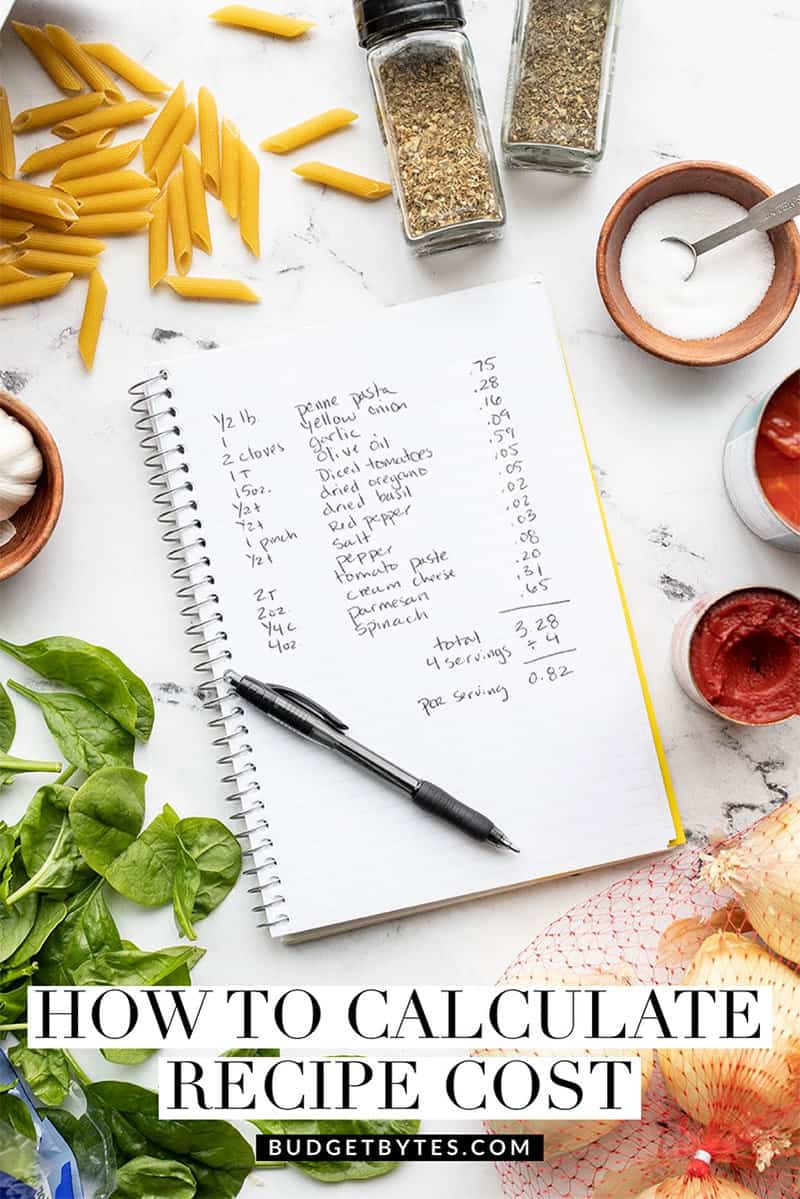
I like your method if pricing each recipes you do.very smart. I will try it on my cooking and see where my money actually go.
Thanks soo much.
Cecilia
Can one also start to calculate the cost of time?
I see this was last updated in 2020. Is it still accurate with inflation?
The method is still the same, but the numbers given will be a little off for sure. I’ll see if we can get this one updated soon!
I was laughing at some of the prices myself 😂😂😂
hi. I’m trying to start a empanada business. I have someone who has the location and wants to buy my product. I’m trying to figure out how much should I charge for them per empanada, and how to calculate it. its all confusing for me. the location is far from me and i would have to drive two hrs to deliver them. Please help. TY
Hey, Jo! I have so much advice in this area, as I used to have a wholesale food business as well! A basic wholesale food pricing formula you can use is: item cost + 20% profit margin = your wholesale cost. Some people add on 15% instead of 20%, but I always had to factor in SO MUCH TIME that I went high. So, if a product costs $1 to make, and the 20% profit margin is $0.20, the wholesale cost would be $1.20. Now, this doesn’t sound like a great profit (and honestly, it’s hard to turn a solid “worth it” profit unless you’ve got a big wholesale business), but once you gain more customers and/or people discover your empanadas which results in bigger orders (I believe in you!) you’ll see it may become worth it. Factor in your time always. (Literally, set a timer on your phone and time how long it takes you to make a dozen empanadas sometime.) Factor in your time + gas/mileage as well if you are also delivering the product. You can add that directly onto the cost of each empanada or have a separate line on your invoice that shows your delivery fee. I hope this is helpful. Some people do it differently, but this is how I have done it in the past and it turned into me opening my own restaurant here in Nashville. :) If you want to chat more about it, you can email me: [email protected] <3 Good luck!
i have an excel spreadsheet that i plug everything into
Item A , is X ounces and cost Y. i calculate cost per ounce and pound
use recipe, plug in ingredient 1 – needs x ounces and it calculates cost
basically same thing you do, but have spreadsheet
i can then go up / down on number of servings and calculate cost, then price to sell at.
Jack. I would love to learn more about how you did this on excel. I am working on projections for a bakery and need to calculate the cost for each item made. Is this something you could tell me more about?
Hi, what would be the best way to cost out a prep item that goes like this: 1080g of dorade fish goes into 776g of fillets and 230 g of bones. the fillets are used for the dish and the bones are used for a fish fumet? I am at a loss trying to cost this out effectively long term
I’d use the whole fish cost. Unless you’re using the bones for something else. Maybe fish broth (?).
Calculate the cost of the whole Dorade fish. Weigh the bones, head, fins, etc, and take it as a percentage of the total cost. Then use that as the cost of fish bones in your fumet/stock recipe. For example:: 11 Lbs of whole fish @ $170 including delivery & taxes; if bones, heads, fins, etc. weigh 20% that would be a cost of $34 for your fumet/stock which you have to calculate separately using on the fumet recipe..
Send me email
I’m not sure if you can help as i live in UK? I volunteer at a local group and have started making meals/cakes etc. Have been given a budget so would like to know how to produce fresh healthy meals within it. And any other tips on budgeting & any other ideas to make this a sustainable venture.
I am starting a home cook and bake business snd can use all tips and information from the experts
Please put a date at least year and area of the country where you are finding such prices. The prices your quoted are more than 10 years old not just pre-Covid but long before that locally here in Washington State the price is you quoted for the entire Recipe would not be enough for one single serving at our current prices
I was thinking the same. I just did a price calc of a casserole I made. Nothing exotic. Came to $3.75 preserving if this made 8 servings. But the servings were tiny. Was in a shallow 8×8 pan. Realistically could be 4 servings ($7.50 per) if no sides (has protein and vegetables in it) or 6 ($5 per) with a side salad or vegetable. But then you have to add that cost. Still cheaper, healthier and tastier than going out in my opinion. Only place we can go out for that price is maybe McDonald’s. I enjoy cooking. I just don’t enjoy the cleanup lol. Anyway, my ingredients here and now are waaay pricier than in this site. Even as I compare apples to apples.
I do appreciate how your mind works. Thank you for your sharing.
food cost
You need to update your recipe costs. They are way out of date on the recent recipes I’ve made.
Thank you for creating this website. My food budget has been astronomical for years. I would eat out 4 times per week and often times when I decided to make a recipe I over spent on the ingredients and one dish cost me a lot more than I expected. I will now be intentional and plan my meals as well as make sure that I have my pantry staples on hand. I am trying to adhere to a strict budget to get control over my finances so no more Uber Eats, instacart, fast food, eating out at restaurants etc. I’m looking forward to cooking my own food and learning how to save money in the process. Thank you again!
Thank you!
Very helpful. Just starting to cook from scratch again. Food is so expensive. I did make a computer spreadsheet instead of pen and paper.
Hi Laura! Do you mind sharing your spreadsheet here or via email?
Thanks, Deborah
Hi, hello thanks so much. For all your information.
I have always wanted how to calculate prices for my home Bakes goodies but never knew how to do it.
I find your method is quite simple and would like to get a better understanding on how to really calculate my cost as I go along.
Would appreciate any further assistance you can share with me.
Thank you.
Anthony
Hello Beth,
Thank you for this site and this break down of pricing out menu items, I found this very helpful and very comprehensive as I am working to price out my menu recipes for an upcoming food tasting as the last part of a Job interview process.
I learned a great deal from your outline and I guess the final and greatest complement would be if I am offered the position. Either way thanks for this information knowledge is power, I am now empowered to do my very best at my upcoming Tasting.
Chef Anthony Mosley
Break legs, Chef! xoxo -Monti
I want to learn more how to calculate my recipes, so far what I see here is easy but until I fully understand it. can’t wait till my brain connect on what I’m trying to learn here and I want to do it with pen, paper and a calculator it’s old school of learning and that is so cool thanks for showing how to do this.
I have always wanted how to calculate prices for my home Bakes goodies but never knew how to do it.
I find your method is quite simple and would like to get a better understanding on how to really calculate my cost as I go along.
Would appreciate any further assistance you can share with me.
Thank you.
Hi. Thank you so much for the information it is very helpful
I’m sure this page is old and your dead and done witht this article but perhaps someone may read this and consider this
maybe I’m a numbers man but to me that sounds like it can quickly run into trouble. WHy not instead just convert everything to the lowest common measurement. Like for example, if a gallon of milk cost $3.19 (whole milk in NYC lol) and since you put all your recipies in ozs, you measure how many ozs of milk you use (16 oz), take the whole price of the gallon milk, divide it by 128, then multiply the answer (2.49¢) by the recipe amount (2.49¢ x 16) and that’s how much the ingredient costed (39¢).
Perhaps I like it because I tend to use exact measurements when I cook, give or take an oz and sometimes I’m not use easy 1/3rd or 1/4th of a packaged good; sometimes I’m using a teaspoon here, 5 oz there. Just a thought
Hi Tevin, That is how we calculate the cost for many ingredients that have exact measurements (see step 4 in the blog post above). The only time we use fractions are for things like a bag of onions where the weights of the onions may be variable, so we average the price per onion by taking the total cost of the bag of onions and divide that by the number of onions. For anything that has an exact weight or volume we use the same method that you suggested.
Hi! We love your site! Can you please trell me if the cost per recipe section has been updated to reflect the current inflation? Thank you!
Hi, Kiley! Unfortunately, no. Since we only have a team of 4 and we calculate all the recipe costs manually at the time of publishing, it would be impossible for us to keep them all (+1200 recipes) updated to reflect current prices. To help, we’ve created an excellent step-by-step guide to re-calculate the costs based on the ingredients available to you. Here’s the link: https://vitalityholisticwellnessguide.com/how-to-calculate-recipe-costs/
If you have any follow-up questions or need help sourcing cheaper ingredients, always feel free to reach out! ~Marion :)
Out of curiosity and for this exact reason; I just tried this recipe with current costs ( at Walmart in Toronto, Ontario) : Total cost: $6.15, per serving $1.53
ouch.
On the plus side, I’m awful at math and this guide was super easy to follow and calculate with!
Hi! I’m curious how often you update costs used throughout the website. You’ve been creating recipes for a loooong time now and I’m sure prices of food have changed everywhere during this time.
HI! It would be impossible for our scrappy, little team of 4 to keep our library of 1200+ recipes updated with current pricing since we do all the calculations manually at the time the recipe is published. That’s why Beth made this handy step-by-step tutorial so you can recalculate the total cost based on new or local ingredient prices: https://vitalityholisticwellnessguide.com/how-to-calculate-recipe-costs/
Hope that helps!
~Marion :)
that was the BE
That was the BEST job of calculations ever. I have done it very loose in my head sometimes I tell my husband this meal cost us $.50 now I think it cost closer to .45. thank you so much
With just the right data and amount to keep moving onto a specific goal (Grocery Budgeting), this post is such a chef’s kiss for an overthinker like me. Definitely turning this into a BuJo entry soon.
About electricty (for utility & prep. costing), I have yet to try but I think using “Electricity Usage Monitors” can help?
Thank you. One of the most practical things I have ever read on the internet.
I’m sorry but where did you get the 4 in the cream cheese?
I’m learning how to price a few recipes and this has been a nightmare..
Hi, Isabel! Great question. Sometimes the manufacturers are nice and provide helpful guides for measuring. This full 8 oz. package of cream cheese cost $0.79, so the cost of the 2 oz. used in the recipe is $0.79 ÷ 4 = $0.20.
So, since the cream cheese is 8oz and each serving is 2oz, there are 4 servings in each regular sized package.
There are some great food cost calculator apps you can download to assist you!
– Marion :)
This is awesome! And, I was just talking with someone on this subject!
Hello, I have a very rich ingredient recipe for a sweet potatoe pie and I’d like to continue to stay a honest person by properly charging the correct cost for my pies. I have a lot of customers and I don’t want to charge to much. I think $20 is to much for one pie but my ingredients aren’t cheap. Please help
Hi Maria, I’m unsure how we can help. What is it that you need? XOXO -Monti
Beth, I love your meticulousness with your calculations. Since I recently became unemployed, I’ll be back on your site more. For your conversions, try the app “Unit converter” by Phil Shadlyn, it’ll do any conversion you want.
And I’ll try making your crispy pizza recipe too.
Hello Beth I’ve learned new things today reading you recipe summary blog. Very informative, straight to the point, leveled to my understanding. I learned your step by step details on how to calculate cost per recipe/servings. Thanks you so much, saved me from future headaches.
Have a great day 11/2022
Where did you shop for the crockpot buttered apple recipe? I haven’t seen prices like that since I was a kid (and I’m 62). I understand you’re you’re calculation method, but, still those prices are way too low! It’s 2022, almost 2023.
We shop at Kroger and Aldi, sometimes at a Latino grocery. We use the price on our receipt to calculate our prices. If we buy a bag of 10 apples for $5 but we only use 4, we calculate the cost as $2. XOXO -Monti
Please add a year to the cost per recipe. Given the recent huge spike in prices, I see a big difference in the costs of items.
You can scroll to the bottom of the post to see the date that it was published. We will be launching a new website soon, and it will be at the top of the post. Thanks for being here! XOXO -Monti
Amazing advise, this article was very helpful. Please try the recipes they sound delicious!
I thought your article was very good. However, I did not see a final recipe ingredients cost list anywhere. I would definitely need that if I start estimating the cost of a recipe. It may be there and I just can’t find it.
Just add all the ingredients cots together. Thanks for being here. XOXO -Monti
It’s an eye opener for me as we go in step by step thanks and much appreciate it cheers
Can I cook this Curry Vegi in a Crock Pot ?
I really would like to thank you so much. It’s been very hard for me to do food cost at my job. Once I became executive chef my boss told me I would have to learn one way or another. I studied your post for a year and when I tell you I got it down pack. I started off with 3 to 5 ingredient recipes first and the more I did it it got easy. Girlfriend you can’t tell me nothing now. It don’t matter how many ingredients it have I’m not scared anymore. And I owe everything to you so thank you once again
Thank you for these tips. I am using them in the High School Cooking class that I have taught for 1 year.
Thank you for th÷ break down. I am going to try it myself. You made it look so easy!
Hi I’m quite confused in some sense. Will you be able to show a recipe that calls for minced meat (pork or chicken). Hope that you will. Be able to help me.
Thank you.
If you’d like to see some examples, here are all of our recipes using ground beef. Can you explain what part confuses you?
I am using your tips but my recipe says ‘1 green chili’ and I don’t know how that would be classed in UoM
Very helpful information thank you!
Goodday! How to calculate the portion size please.
That’s just something you decide for yourself. :) It’s not a standard calculation.
Maybe a silly question: My recipe includes water. Do you account for that or consider it “free”?? Thanks for the help. Your article has been very helpful.
I round costs to the nearest cent and even if I use several cups of water in a recipe that would cost me less than a cent, so it gets rounded to $0.00. As with all ingredient prices, they can vary quite a bit from person to person. :)
Do I have to add ingredients yielded price, when I cost recipe? Is it important ?
I’m sorry, I don’t understand the question.
What is the formula or the methods for baking to work out the price.
Are you asking how to figure out the cost of the energy used to bake?
Thank you so much. You have made this process simple. I am making some hand and body lotions and trying to figure my costs.
Thank you for your help. I am still a bit confused because there is a lot to take in but I see the more I do it it will get easier. So thank you. Theresa
T
Yes I’m still a lot confuse sometimes it seems easy but when I start doing it I just get confused about it all
In calculating the costs recipe cost, i find the information very heipful and easy to follow.
Thanks so much for the article, I’ll definitely be using your tips. But te me, do you charge for labour also? And how would you go about calculating it? Thanx
If you’re running a commercial foodservice, then yes, you would also want to calculate in labor, utilities, rent, and other overhead costs. For labor, you would just multiply the hourly wage that you pay the employee by the amount of time it takes to prepare the recipe.
HI Im starting my own home bakery making cheese cakes. but my delema is costing out supplies like parchment or cooking spray or the light/energy bill. What you Recommend?
Parchment and cooking spray could be done with the same method as above (estimate how many uses, divide the total product cost by the number of uses, then add that to your total recipe cost). Light and energy would be totally different. You’d need to figure out a way to estimate the monthly cost of those utilities, then divide that by the number of recipes you can produce in a month, and add that to the cost of each recipe.
I was taught how to calculate recipes during culinary school. I am currently working on a catering menu and doing cost cards to determine what to charge, for the life of me, for whatever reason, this one item is causing me a lot of trouble. I am not going to go into much detail, but for my bacon chicken bites, my total ingredient cost was 10.07. With my recipe making 10 servings, that left me with a $1.07 per serving. If I did a 30% desired cost, that just comes out to $3.67.
Long story short, I have no idea how much to charge for my bites?! My recipes yields 30 bites (3 bites/serving). I put my price on my menu based on 10 servings. Can you please help me. Thank you
$10.07 cost x 3 for the markup on the whole pan of 30 meatballs = $30.21 (feed 10 people, 3 meatballs each)
Round up for the number of pans based on final guest count. 1-10 (1 pan) 11-20 (2 pans) etc. Hope this helps.
Wow, not sure where you live, but in canada this much shrimp is upwards of $10. And a handful cilantro is at least $3.
I was thinking the same thing. $.79 for a package of cream cheese? $.69 for mozzarella? Maybe in 1986… (cries in Canadian)
Thank you so much for this, it’s super helpful!
I started doing this WAY back when I first came across your website. I kinda became a geek with calculations of recipes, and I love it. Thank you.
Dear Beth,
Well done, well written as usual.
I need to do this for yacht provisioning fairly often so I’ve built a spreadsheet. The methodology is the same. I can’t imagine any other way to do it.
Even if you have the receipts you may need help. Sometimes, at least at the groceries I frequent, the description is unclear and I can’t figure out which line is the one I’m looking for. In addition sometimes the print tape is running out and the text is too dim to read. As you say, many groceries allow looking up prices which is a big help. An equally big help is going to Budget Bytes and finding a recipe that has that ingredient. *grin* You can use Google with a search term like ‘tarragon site:budgetbytes.com’ or just go to Budget Bytes > Recipes > Ingredient Index. As it happens you don’t seem to be a fan of tarragon as the only entries I could find were in reader comments. ‘thyme site:budgetbytes.com’ worked brilliantly. *grin*
I am one of those who have written about utility costs. Coming up with guidelines is actually not too hard, just tedious. People would have to make do with national averages. It wouldn’t be difficult to come up with costs for preheating an electric or gas oven and costs per time period for cooking in oven or stovetop (high/medium/low). I’d happy to write an article for you if you like. If nothing else you’d have a resource to point to when you say utility cost doesn’t matter.
best, dave
Several years ago, a well-known fast food chain had some commercials that challenged home cooks to make their family meal deal at home for the same price it cost at their restaurants. It had Mom and the kids making a mad dash through the store, trying to buy all the ingredients that went into making the meal, with a running total of the costs on the screen. It didn’t last long. I suspect that some home economists and other experts put them straight on how such things are actually calculated!
Here’s an idea – when you buy an ingredient, write the price on the bottle, jar, or box with a sharpie for quick reference. Or even better, cost per Tbsp, or whatever the amount is that you usually use.
I agree on this idea. Being a strict budget lady, I mark prices on all my boxes & cans.when I bring home the groceries. It is also very helpful when you have to replace an item so you have an idea of what things will cost. Before I shop I check all the weekly flyers for sales on items I use regularly. If I run out of something that is not on sale that week, I check prices on local store web shopping sites. The price difference for identical products can really vary, so check them out. I keep a weekly list of good prices in my local stores. You can save a lot of money with a bit of planning & price checking. I do it so often I remember normal prices and can easily spot good prices. My friends call me a super-shopper. I am proud of the nickname.
Thanks! Great and practical help
Unless you already mentioned it and I missed it, may I ask where you usually shop and do you buy generic whenever possible? I eat organic primarily, and it is a challenge shopping budget-wise as you seem able to do. Otherwise, I appreciate your recipe ideas.
The places that I shop have changed over the ten years that I’ve been blogging because I’ve moved several times and my preferences have also changed. Right now I’m in Nashville so my shopping is mainly split between Kroger and Aldi, both of which have decent organic selections for good prices. :) Whole Foods actually has good prices on their generic brand. Shopping on a budget does take some skill, but I think you’ll find that you get better at it over time! Just always keep your eyes peeled and check out other stores to see what their selection and prices are.
Thanks a lot
Your on track, now we add .10% for waste, utilities, that’s gas, electricity, water, labour, packaging, don’t forget equipment.use with depreciation too and that covers the cost. Now all I have to do is. X 3 for Retail, × 4 for wholesale prices and that basically covers it. So if your keeping Foodcost @ 32% then ., I know what to do
Hello chef
I like your comments about the missing points above, Most of the time when we cook not commercially, we do not add waste, utilities, gas/ electricity, water, labour, packaging, equipment depreciation etc. BUT it is very important. when we add all these, the cost per person/ per dish, will change dramatically
I cook veggie foods. Recently I have an inquiry for noodles for 50 kids. Can you please help me with the portion and the costing for noodle per plate? I will appreciate your help.
Thanks
Hi
I found recipe cost calculator app for iPad recently. I like it a lot.
Thanks for doing this.
I bake from home for family and friends , I need a better way to keep all my prices on hand and be able to update them , how do you recommend me to do that?
Perhaps you could build a spreadsheet?
Excellent post! I read your blog regularly and you always
post really great stuff. I shared this on Facebook and my followers really enjoyed it.
Keep up the great work! :)
Thanks for the info.
Just what I was looking for,much appreciated.
Michael,
(Melbourne,Australia)
Just wanted to let you know (in case it helps anyone)…Things like minced onion, italian seasoning and parsley flakes have 10 teaspoons per ounce and ground spices like ground black pepper, garlic powder, and cinnamon have 7 teaspoons per ounce (I weighed them…lol). so, if that helps anyone get a more accurate price.
Thanks for this.. it really helped me out
This is so awesome. Thank you! I am trying to lay out my menu plan with meals and cost of ingredients in my bullet journal. My hope is to take my monthly food budget and look at the meal page to determine what meals I can afford to cook that month.
Also, have you thought of revisiting this post and possibly turning your info into a printable or infographic? Might help readers digest the information and would get you a lot of traffic/(possibly) new readers from Pinterest. :) I know I’d love to see a printable of some sort!
Great idea! Thanks!
How can I cost my alcohol ingredients? What is the best way to make a recipe in margarita cocktail mixing.. thank you I hope you will reply..
Eggs
Thank you very much for posting this information. Is going to help me out big time!! Much appreciated!! :-)
This is a great idea.
I think the main idea of this can be used on a website I found.
http://www.cookkeepbook.com
They are making a scheduler soon that can help you plan your purchases.
This is a great start. Do you have any posts that say what you generally have stocked in your pantry? I’m assuming rice, onions, pasta, celery, seasonings (salt, pepper, cumin, chili powder, onion powder, chili powder, thyme, rosemary)….
I have this post that I made many years ago, but I plan to update it soon. I have an updated list in my new book, too. :)
i hope this website helps me because i dont know how to cook right!!!
this thing help me a lot
thanks>>>>
My wife (who is a chef) and I play this game whenever we go out to eat for our fancy dinner out, it’s a fun geeky dinner game! I live in Vancouver (BC), so our food costs are *way* higher than yours (I’d say almost double!). You cannot find bags of onions for $1.50 here, the cheapest I’ve ever found was at Superstore and it was a bag for $3. Definitely no chicken for $1.99/lb (we choose local chicken that’s lived outside and eaten normal chicken things, we just eat less of it. But the lowest I’ve found for chicken in Vancouver is around $4/lb.)
I love love love your blog, it’s so easy to sub things. Your meals also freeze super well (which is pretty much how we are thriving, with me doing crazy full-time shift work and my wife absolutely buried in full-time school). My newly started blog (born out of my co-workers lovingly teasing me about my “super healthy lunches”) features your stuff a couple of times already, and it’s only been up for a week. Ha! :D
What supermarket do you go to with prices so cheap? My local Safeway and Fry’s food is more expensive
Prices definitely vary from region to region. For the past two-three years I’ve shopped mostly at my local grocery store, which is a local chain and the prices tend to be a bit higher than most national chains (Walmart, Target, etc.). It definitely helps to catch sales and explore other stores in your area to compare prices.
I do the same thing. I like to calculate the cost of a meal and compare it to the cost of having the same meal at a local restaurant. Having done this many times I know I can eat better and healthier at home for less money and minus the costs of driving and the time waiting…awesome post!
This website is so, so great. I’ve been bookmarking recipes here and there for years and just wanted to say that your site has been SO helpful for this little family on a budget. The design looks beautiful! (I haven’t clicked out of Reader for awhile til today.)
Keep up the good work :)
This will help me so much!!! I’ve never really sat down to do a breakdown like this. LOVE!
A question. How do you deal with the stuff you have on hand? Do you calculate the cost per cup (eg. flour) when you get it and put a piece of sticky tape on for when you use it in a recipe? I dont understand how to start with a full pantry and freezer. Do you look at a flyer and make a best guess on price or go to a store and price it out even tho you dont need to purchase anything for your meal? And how do you deal with garden veg or fruit trees in your yard? do you keep track of the price of the seed packet, the water, fertilizer you used, the amount of electricity used when starting the seeds under lights, the cost of your community garden plot, etc? example. i got four ice cream pails of raspberries last year because i gave lots away, and six or seven the year before. but i had to pay x40.00 to have them cleaned out last year and paid some amount to haul in fertilizer and bedding this year, and the season is not done for this year so I dont know how many Ill get or how much money Ill spend on the patch. So while the cost of the berries isnt free, it cant be calculated either … So whats my best bet: pick something from a flyer as a best guess?
Well, when you’re first starting out I would suggest taking note when you’re at the store of the price, serving size, and servings per container of items that you already have in your pantry (flour, sugar, oil, etc.). You don’t have to do them all at once, just jot down which ones you need for that week’s recipes and do a few at a time. As suggested in the post, you can keep a spreadsheet of these staple item prices so that you can quickly refer back when calculating recipes in the future. Then as you repurchase them, you can enter the new prices to stay current.
I like to calculate my recipe costs as accurately as I can without pulling my hair out. That means I don’t worry about garden vegetables, electricity costs, or things like that. I do the calculations to give myself a good estimate of what I’m spending and even though it’s not 100% accurate, it’s still very eye opening. I use a lot of estimates in my calculations, like for the spices or garlic cloves, but it’s still very helpful. Personally, I would consider the cost of the garden a “hobby” expense in my household budget and the resulting produce free. :)
Don’t kill yourself over it, you’ll still be blown away by what you discover along the way! Good luck!
Beth! Thank you so much for this!
Due to some changes in our life, my partner and I are on a smaller budget, but have much more time to cook at home! I’ve been calculating the cost of our meals, and it’s really helped a lot in keeping us on track. Though we still get occasional takeaways (or as you Americans call it, takeout :-)), we’re much less likely to when we see how much it costs compared to a home-cooked meal! My partner is a total convert.
Thanks for the tip about using the serving sizes on the packet! I hadn’t thought of that before and I’ll definitely do it in future. I have been keeping track of things in a nerdy spreadsheet, haha!
Thanks again Beth!
This is a really useful post! Super interesting to think about actually calculating the real cost of meals. The only problem for me would be remembering how much all my farmer’s market produce cost…
Yep, that’s tricky. I’ve avoided joining a CSA because I wouldn’t be able to offer the price breakdown on the blog. If I didn’t have the blog, I would just say “oh well” and join the CSA, but I like to give grocery store prices for reference :P You could always just use an estimate, though. I’m sure it would still be helpful!
It would definitely be worth it to join a local CSA. You would be helping out local farmers, eat great fresh produce, & saving some $. You could uses store prices for the blog, making note of them while already shopping for the other ingredients.
& I have a bacelors in finance so math is my friend :)
Thank you so much Beth! I can’t wait to try this out!
Thanks for the tutorial. In general I do not enjoy math, but when it saves me money……I’ll do it. :)